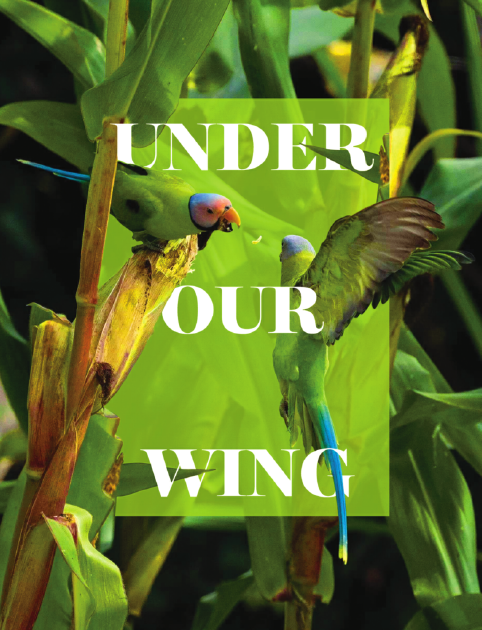UNDER OUR WING
New study explains how humans can protect and manage the avian population to the benefit of farming croplands, Li Yingxue reports.

Humans and wildlife often have to share areas of land. And on croplands, particularly, avian and human lives can intersect to the benefit of both. Yet the beneficial services provided by birds, for example pest control, are less visible than the disservice they do in terms of direct damage to crops. Since farmers mainly care about what they can observe directly, this often leads to birds being wrongly perceived as pests that need eliminating.
In a groundbreaking study that transcends borders and ignites a renewed fascination with the natural world, postdoctoral researcher Huang Cheng from School of Life Sciences, Sun Yat-sen University in Guangzhou, Guangdong province, together with his colleagues, has unveiled profound insights into the captivating relationship between birds and humans on croplands that may lead to more harmonious coexistence between the two.
Published in the esteemed peer-reviewed journal PLoS Biology on July 7, a paper lead authored by Huang, titled "Insights into the coexistence of birds and humans in croplands through meta-analyses of bird enclosure studies, crop loss mitigation experiments, and social surveys", has captured the attention of the scientific community worldwide.
Their research findings suggest that birds typically enhance woody crop production, but not herbaceous crops, highlighting the significance of crop loss mitigation efforts for harmonious coexistence between birds and humans.
The study also reveals that nonlethal, technical measures, such as scaring devices and adjusted sowing practices, are more effective in reducing crop losses compared to elimination methods such as poisoning, shooting and netting.
Additionally, Huang and his colleagues found that stakeholders from low-income countries tend to perceive the impact of birds on crop losses more negatively than those from high-income countries.
According to Huang, 33, drawing upon compelling evidence, their research has pinpointed potential regional clusters, with a particular focus on the tropics, where win-win coexistence strategies can flourish.
Through meticulous analysis, they equip stakeholders with effective evidence-based solutions to seamlessly integrate bird conservation and management practices into croplands. Huang says that their findings pave the way for fostering a harmonious balance between agriculture and avian ecosystems.
Two worlds collide
Huang has been studying conflicts between humans and wildlife since his doctorate. When he was studying at Kunming Institute of Zoology, Chinese Academy of Sciences, he surveyed on the conflicts between humans and Asian elephants.
He started to study the coexistence of birds and humans in 2019. "The habitats of humans overlap significantly with the habitats of wild animals, including birds. Birds, in particular, are most likely to come in close contact with humans, which inevitably leads to some conflicts between the two," Huang explains.
Professor Liu Yang, from School of Ecology, Sun Yat-sen University, is co-writer of Huang's article. Liu, 42, is an expert in ornithology and previously authored the CNG Field Guide to the Birds of China.
According to Liu, birds provide vital ecological services, transcending human perspectives to influence the ecosystem as a whole.
Liu exemplifies the significance of bird contributions, such as aiding in plant pollination, a critical process for plant reproduction, and actively participating in pest control by reducing insect populations. Birds, as ecological stewards, play a crucial role in maintaining the delicate balance of nature and fostering the thriving coexistence of diverse species within an ecosystem, he says.
According to Liu, previous research into occasions when humans came into conflict with birds was often confined to single disciplinary fields or specific geographical regions. However, Huang's study, known as a meta-analysis, brings together different research cases for comprehensive study.
The research conducted by Huang encompasses various disciplines, such as ecology, sociology and others, within which he has reviewed over 18,000 papers pertaining to related topics, and filtered 122 articles for further analysis.
The first part of the study examines the net effect of birds on crops. According to Birds of the World, approximately 10 percent of all bird species consume crops.
A study of the ecological and economic services provided by birds on Jamaican Blue Mountain coffee farms shows that birds control coffee berry borers and thus increase coffee yield and farm income, which is a potentially important conservation incentive for coffee producers.
Huang and his colleagues also looked at the effectiveness of mitigation measures and found that nonlethal measures to deter birds are more effective in reducing crop losses.
"The simplest methods are sometimes the most effective," Huang says. "We found that, on a farm, simply using ribbons can reduce the loss of crops to birds."
Huang's study also reveals that simply changing sowing practices such as sowing deeper into the earth, or aligning sowing timing with bird migration patterns, can effectively reduce crop losses attributed to birds.
Peaceful resolutions
The reason Huang conducted this part of the research is to encourage farmers who currently use lethal methods to prevent crop losses from birds to switch to nonlethal methods.
As an example, in Thailand, there is a type of bird that causes damage to rice crops. Local residents set up nets on the edges of the fields, which are not easily noticeable, causing many species of birds to collide with them and die, 20 percent of which, according to research, are from species that don't cause crop loss.
"This practice leads to a decline in bird populations in the area and also reduces the ecological services provided by birds," Huang says.
To understand the public perception of and attitude toward birds, Huang compiled a data set including 39 independent surveys for over 25,000 respondents from 24 countries, mostly from questionnaires retrieved from study areas.
Analysis revealed that the average proportion of respondents who had a positive attitude toward birds was at least twice as many as those with a negative attitude. Although the pest control benefits offered by birds are widely recognized in global biodiversity conservation agreements, only 61 percent of the rural residents from eight surveys thought that birds could benefit crops.
The research findings indicate a notable disparity in perceptions among respondents from different income backgrounds. Those from low-income countries tend to view birds as an issue, expressing less positivity toward them compared to respondents from high-income countries.
Tropical regions harbor a higher diversity of bird species, making bird conservation particularly crucial in these areas. However, many tropical regions are often low-income countries, relying heavily on crop production.
"So, they may be more sensitive to the crop losses caused by birds, leading to more apparent conflicts between humans and birds," Huang says.
"Therefore, we believe that it is essential to first initiate awareness campaigns in these countries promoting nonlethal control methods and fostering understanding of the beneficial relationships between birds and various agricultural fields."
Liu believes that while the article takes a global view, it also provides significant insights applicable to China. For instance, biodiversity conservation is an essential aspect of the country's efforts to establish an ecological civilization.
He says he is planning to conduct research on the interactions between birds and agricultural ecosystems in Dehong, Yunnan province, where conflicts between certain bird species and farming activities have been observed, similar to those discussed in the article.
"In these provinces with rich biodiversity, similar challenges arise. Our goal is to find a balance or solutions that address both conservation and development concerns," Liu says.


Today's Top News
- China intensifies financial support to spur consumption
- China marks milestone in developing complex deepwater oil and gas reservoirs
- China remembers victims of Nanjing Massacre, 88 years on
- New plan will be a road map for a stronger future
- Taiwan's character of the year a vote against confrontation
- Strengthened resilience key for economy






























